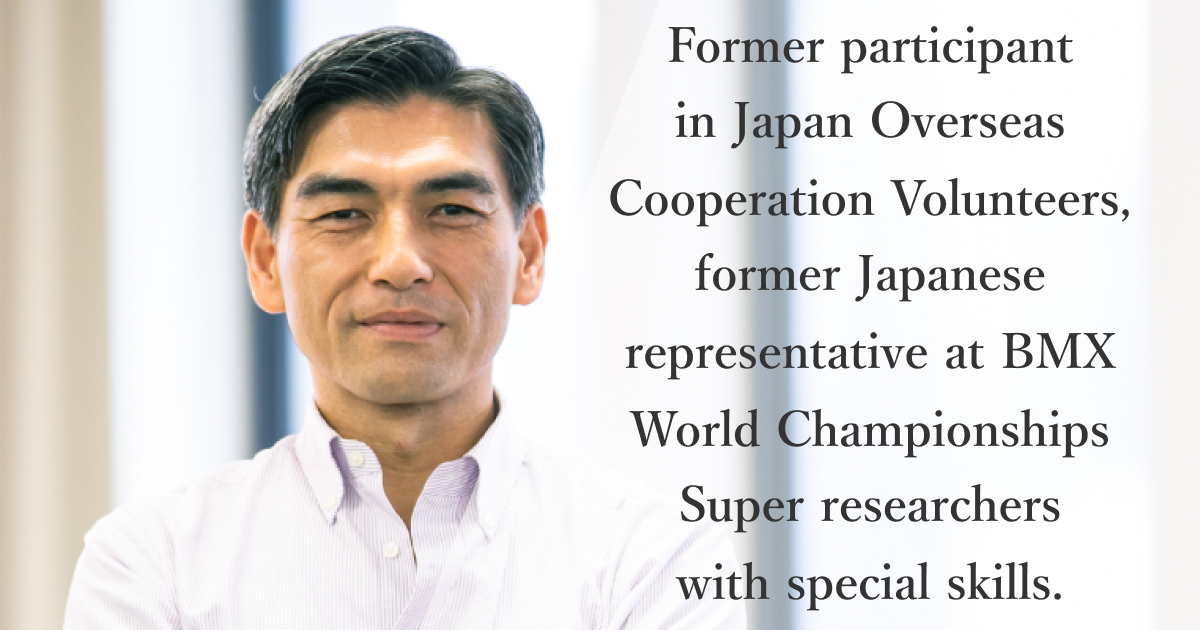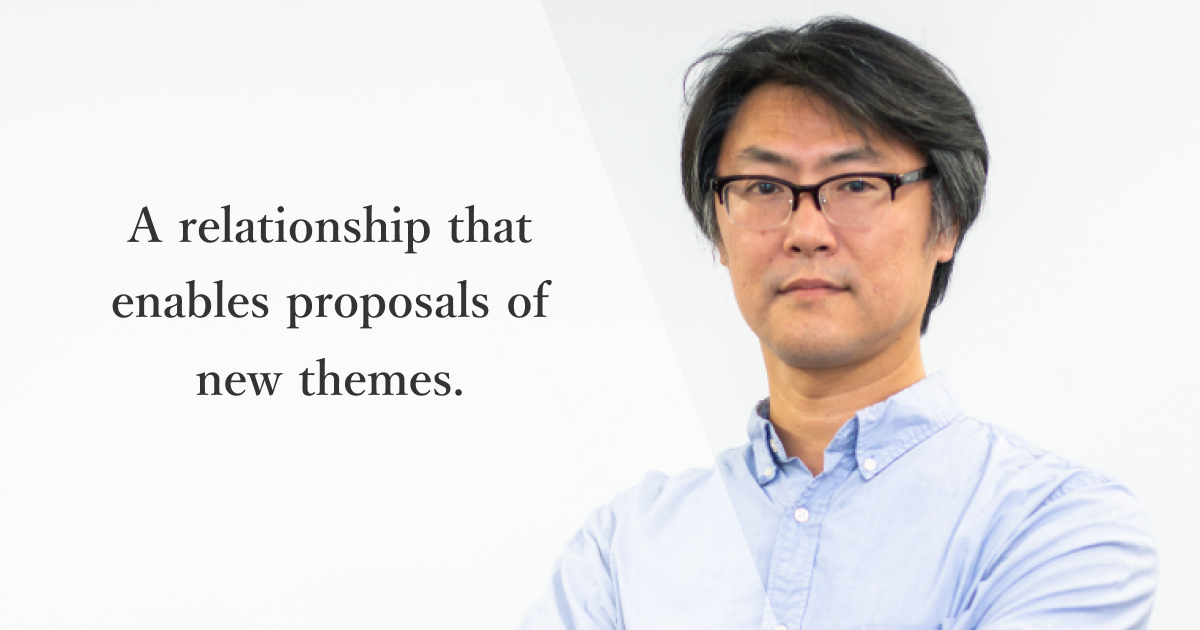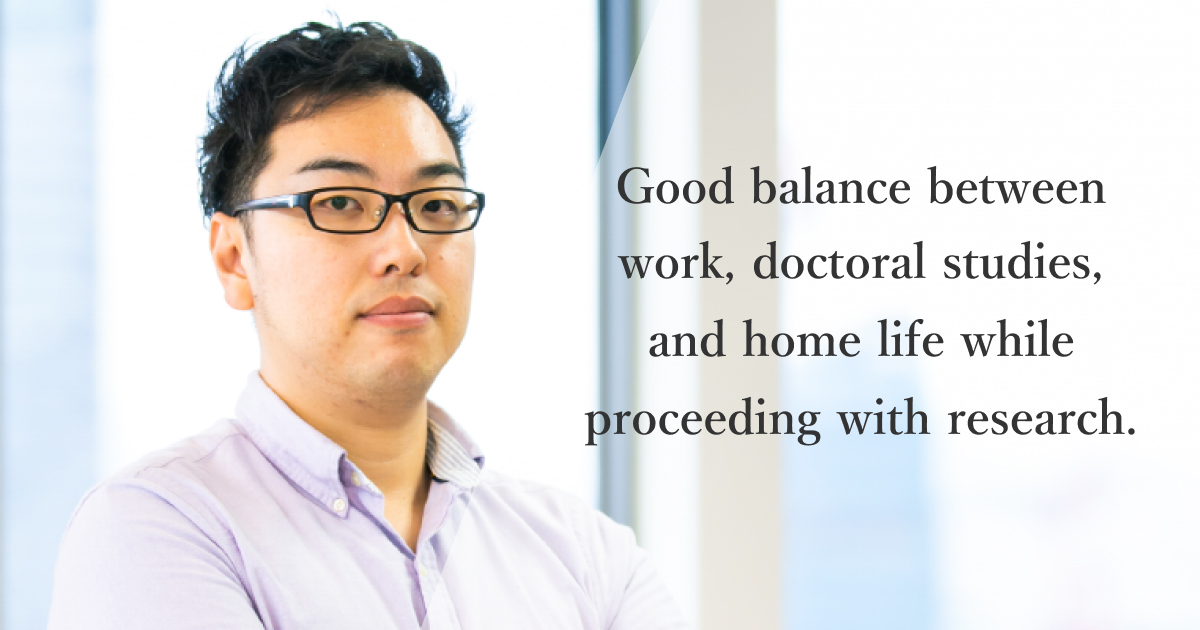Research & Development Group, Senior Researcher
HMI
Hiroshi Tsukahara
Hiroshi Tukahara
PROFILE
Joined company in 2006
after working on information processing for
maps
The relationships necessary to make new proposals
Mr. Tsukahara does joint tasks with DENSO and research into cooperative dialog with robots. His background includes a limitless intellectual curiosity toward science and mathematics. Using ideas from geometry to discover rapid calculation algorithms for enhanced learning, as well as hints from field theory to devise a method to calculate spatial relationships within language, Tsukahara is a researcher who moves freely between the worlds of theory and algorithms. We asked him about the relationship between theory and research.
Working on “dialog” as an interface with future importance
My present research theme is a dialog interface for life-style support robots. Originally, I had been exploring the issue of preventing driver sleepiness, something which autonomous cars are expected to address, and was researching chat systems. In addition, I was also researching voice recognition operational algorithms for application with the user interface of the tablets distributed as part of “life vision,” a regional information service that DENSO had developed as a new initiative.
As part of that, we received the lifestyle support robot HSR (Human Support Robot) from Toyota, and researched dialog interfaces. HSR is provided to many domestic universities, research institutions and corporations. There’s also a competition called the “partner robot challenge” that takes place at the world robot summit. For Toyota as well, I think providing HSR to many researchers is a way of exploring its usability.
When you talk about “communication with robots,” a lot of people imagine something like Toyota’s Kirobo mini, but we’ve actually gone beyond that to research dialog with robots that move and manipulate objects in real space. For example, if you say “place my iPhone on the table next to the cup,” it’s currently possible to convert the audio information from your voice into text, but to use that to operate a robot, it has to conduct natural language processing to know which parts of the sentence are the object and which parts are instructions about spatial relationships. Next, it has to understand and process 3D relationships, as well as how it should move on the basis of that recognition. From that, it gives instructions to the actuator on how to move.
Lastly, to issue correct instructions, “grounding” becomes important as a way of responding to words and the real world. Behind the phrase “next to the cup on the table” is the implied knowledge that a table exists and that the base of the cup must be placed so that it makes contact with the surface of the table. Since factory robots carry out specific behaviors in specific environments, issues can be addressed with programming, but a robot that moves within a household must conceive of an infinite number of different environments and carry out irregular tasks. In some cases, that means finding harmony with humans.
That also applies to the voice activated interfaces for autonomous cars. There are an infinite number of road shapes and surrounding environments, so to achieve safe driving, it will be necessary to cooperate with humans to carry out those things that cannot be understood and processed using human language. In my joint research with the Ochanomizu Womens’ University Professor Ichiro Kobayashi and Keio University Professor Gaku Omae, we are studying ways to issue instructions to and operate autonomous cars with the use of actual spoken dialog. Through that research, we’re able to propose new research themes to DENSO.
Everything I’ve learned is tied together
Right now, I am researching dialog interfaces, but as a student, I majored in physics. My undergraduate research was into chaos theory, while my master’s degree was earned with the study of phase transition phenomena in non-equilibrium systems. Finally, my doctoral course focused on the unsolvability of the statistical mechanics that govern things like the macromolecules in liquid crystals. Using the programming skill I gained from developing computational geometry algorithms as part of that research, I developed a mapping system at the company I joined after graduation. Since ITS (Intelligent Transport Systems) is one of the applied fields where information processing is essential, I built a connection with Denso and in 2006, I joined DENSO IT Laboratory (hereafter IT Lab). When I first joined IT Lab, they had just started research into image recognition technology. That’s when I first began using neural networks.
One of the things that surprised me when I began researching neural networks was that I could use the knowledge I had gained with physics and math as a student. For example, the Bayesian approach to computational geometry is necessary to build models or for evaluating the performance of learning devices. By the way, several years ago, I used geometric duality transformation to develop a model for a high speed-enhanced learning model.
When I was looking for a research theme related to rural networks, the idea of researching drive recorders came up. At the time, however, they weren’t used in most consumer automobiles. To improve the rate of adoption, drive recorders needed to record not just accidents but also normal driving experiences. As such, my joint research partner, Toyoaki Nishida from Kyoto University, and I conceived the idea of a system that accumulates in-car conversations as well as on-board images into a database. That was what led me to start researching voice-activated interfaces.
I’ve worked on a lot of different themes since my years as a student. These may look like completely different routes, but for me they involved looking at the things that were important to me at the time, and it was a natural transition. Looking back, it feels like all these different themes are tied together. And my past research has not gone to waste.
Using instincts as a physicist to pursue breakthroughs
I moved from my first employer to IT Lab because it seemed like a place where I could concentrate on research. In my previous job, my time was limited to research into macromolecular topology, the focus of my university study. I figured that by joining IT Lab, I could be involved not just with manufacturing but also more fundamental research, and that’s why I switched.
My thoughts since joining the company are that there is no better environment for people who want to focus on research. Each employee of the company is a researcher and the company slogan of “being the most productive researcher we can be” is something that can only be achieved here.
Outside of work, I spend most of my time reading books on mathematics and physics. Doing that often gives me new ideas. More recently, I’ve looked into electronic computer twister theory and spin structure. These are things that I’ve studied out of simple intellectual curiosity, so I’m also interested in forms of algebra that combine Clifford Algebra with conformal geometry, as I think those might have more practical applications. To correctly understand spatial relationships expressed in verbal language, it’s important to recognize where the point of reference is, and by using Clifford Algebra to incorporate three dimensional spaces into a five dimensional Minkowski space, we can conduct spatial calculation based on points of reference and I think that can be adopted for research into grounding.
Even if you define IT Lab as simply a place for research, our work still requires a social element, so it’s a fact that research for the sake of theoretical or mathematical physics is difficult. However, with the example of material development, we can carry out research into the magnetic material necessary for a good motor, and that will enable research that will clarify fundamental principles. Or with electronic computers, I think the issue of secure encryption enables research that would eventually have practical use. Right now, deep learning has enabled dramatic improvement in the precision of voice and image recognition, but in the future, analysis of meaning and processing of knowledge will also be important. I believe that natural language processing is essential to addressing those problems. It may seem on the surface to have no direct relationship with DENSO, but I believe that it will become necessary in the future.
My goal is to be the go-to staff member in the DENSO group when people think about dialog interfaces. That’s already happening little by little, but I think my current task is to help others at DENSO realize the importance of “dialog” as a theme.








